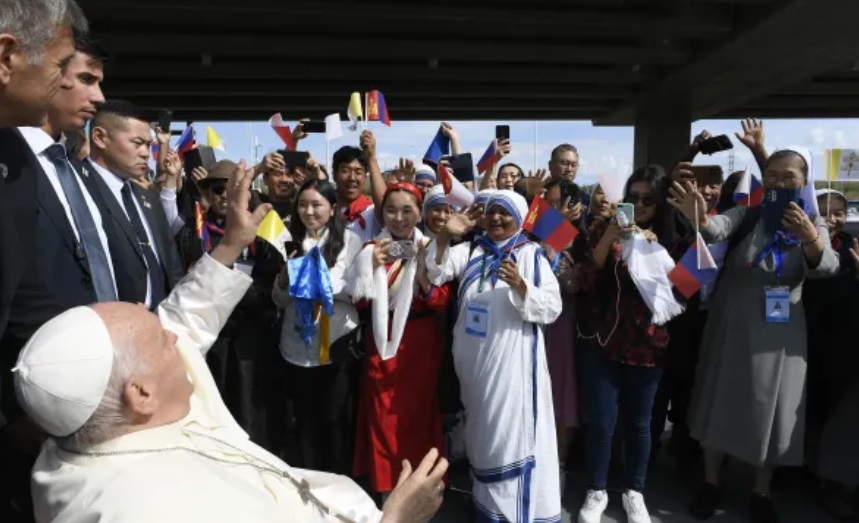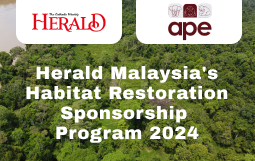Pope Francis’ six great moments in Mongolia
Here is a round-up of Pope Francis’ trip to Mongolia, a central Asian country with around 1,500 Catholics.
Sep 15, 2023

From August 31 to September 4, Pope Francis visited Mongolia, as the destination of his 43rd apostolic trip abroad.
This central Asian nation welcomed Pope Francis with great excitement on this visit marked by geopolitical undertones and historical significance.
1. First Pope to ever visit Mongolia
After a more than nine-hour flight, the first Pope to ever visit Mongolia landed in its capital on September 1, 2023, having left Rome the previous evening. After a welcome ceremony at the airport, the Pope went to the Apostolic Nunciature where he rested for the remainder of the day.
This didn’t stop small groups of citizens from waiting for him on the streets of Ulaanbaatar, or the government from organising a traditional banquet in his honour. Although he was not expected to attend, the event was marked by several hours of performances manifesting Mongolian culture, including horse racing and archery.
The Pope’s Secretary of State, Cardinal Pietro Parolin, attended the celebration as the Pope’s representative.
2. The Holy See and Mongolia: A long history of relations
On September 2, Pope Francis participated in his first engagement in Mongolia, meeting with state leaders, politicians, local authorities and the diplomatic corps. Pope Francis met with the country’s president, Ukhnaagiin Khürelsükh, and gave him, as a gift, a copy of an ancient manuscript held in the Vatican Library.
Dating from 1246, this letter showed some tension at the time between Pope Innocent IV, and the ruler of Mongolia, the Khan Güyük, Genghis Khan’s grandson. However, Pope Francis wanted to remember it as the first historic contact between the two states and hoped it could be a “sign of an ancient friendship that is growing and being renewed.”
The Pope then gave a speech to the authorities, highlighting how Mongolia is, and has been, a promoter of peace and religious freedom throughout history.
“A profound spiritual sensitivity belongs to the very fibre of your cultural identity, and it is proper that Mongolia should be a symbol of religious freedom. In the contemplation of boundless and sparsely settled horizons, your people have developed a refined spiritual sense, born of nurturing silence and interiority,” the Pope explained.
He then highlighted how Catholics can also contribute to the future of the nation.
“I am pleased that this community, however small and discreet, shares with enthusiasm and commitment in the country’s process of growth by spreading the culture of solidarity, the culture of universal respect and the culture of interreligious dialogue, and by working for justice, peace and social harmony,” the Pope said. “I am certain that Mongolian Catholics will continue to offer readily their proper contribution.”
3. Our Lady of Heaven: From the garbage to cathedral
After meeting the political representatives, Pope Francis went to the Cathedral of St Peter and Paul to meet the country’s small Catholic community, made up of only eight parishes and featuring the Church’s youngest cardinal. Before the event began, he met with an elderly woman, Tsetsege, who, more than a decade ago, found a statue of Mary in the garbage. Our Lady of Heaven, as the statue is called, now has a special place in the Cathedral.
“Let us acknowledge too, all those many faithful servants of the Gospel in Mongolia who are here with us now and who, having spent their lives for Christ, can ‘see’ and ‘taste’ the marvels that His goodness continues to accomplish in you and through you,” Pope Francis told the clergy, missionaries, and other Church workers present, remembering also all those who have contributed to the evangelisation of Mongolia in the last 30 years of Catholic presence in the country.
“The Lord Himself has chosen you and believes in you; I am with you and with all my heart I say to you: thank you; thank you for your witness, thank you for your lives poured out for the Gospel!”
4. A unique interreligious meeting
On September 3, Pope Francis met with 11 different religious leaders, representing the many faiths in Mongolia. He notably heard Kamba Nomun Khan, abbot of the Gandan Buddhist monastery in Ulaanbaatar, who highlighted, without stating names, the different persecutions that his Buddhist brothers have suffered in the past and still today. Buddhism is the majority religion in Mongolia.
The Pope then heard from representatives of the Shaman, Orthodox, Jewish, Baha’i, Muslim, Hindu, Evangelical and Adventist communities.
“Here indeed, the sky, so clear and blue, embraces these vast and imposing lands, as if to remind us of the two essential aspects of human life: the earthly, made up of our relationships with others, and the heavenly, consisting in our quest for the transcendent Other,” the Pope said.
“Brothers and sisters, the social significance of our religious traditions can be gauged by the extent to which we are capable of living in harmony with other pilgrims on this earth and how we can foster that harmony in the places where we live.”
5. “Ciao, Ni Hao, Viva Il Papa”
On Sunday afternoon Pope Francis celebrated Mass for the Mongolian faithful and the hundreds of other Catholics that came from neighbouring countries. There were, notably, a number of Chinese Catholics that had come to see the Pontiff, despite a ban by their government. They had been noticed on the streets of the Mongolian capital, often covering their faces or avoiding questions from journalists.
At the end of the Mass, in an unexpected and spontaneous move, Pope Francis sent a direct message to China, while taking by the hand the Bishop of Hong Kong, cardinal-elect Stephen Chow. The Pontiff asked Chinese Catholics “to be good Christians and good citizens.” “Ciao, ni hao, viva il Papa,” they shouted, a mix of Italian and Chinese meaning “Hi, hello, long live the Pope!”
“In this life we often experience the desert with loneliness, fatigue and emptiness,” the Pope said during his homily to the around 2,500 faithful present. “The Christian faith is the answer to this thirst. For in this thirst lies the great mystery of our humanity: it opens our hearts to the living God, the God of love, who comes to meet us and to make us His children, brothers and sisters to one another. Let us never forget: love alone truly quenches our thirst.”
6. House of Mercy inaugurated in Ulaanbaatar
For his last event on Mongolian soil, Pope Francis inaugurated the House of Mercy, a centre for the Church’s charitable activities that will assist the homeless and others in need in Ulaanbaatar. “Though small in size, [the Church in Mongolia] life is marked by fraternal communion, prayer, selfless service to those in need, and witness to its faith,” the Pope said, remembering how the missionaries that came to the country in the 1990s “immediately sensed a summons to works of charity.”
He noted his hopes that this new charity centre will welcome people of all faiths, either as volunteers or as people using its facilities.







Total Comments:0